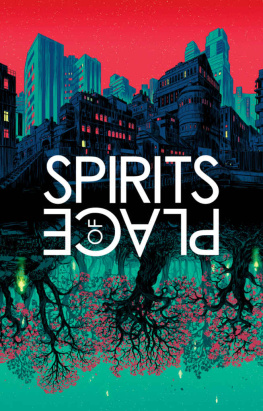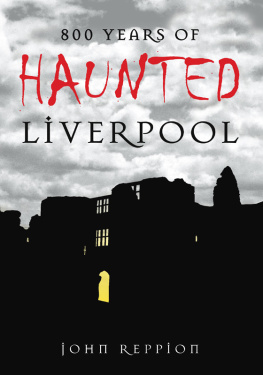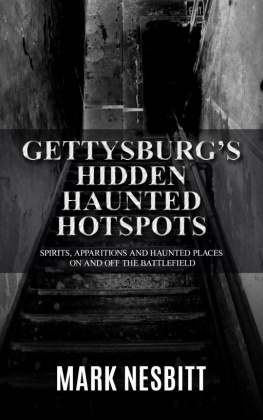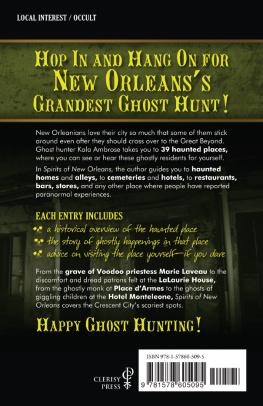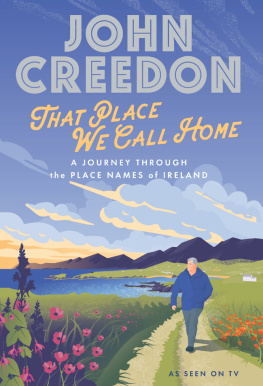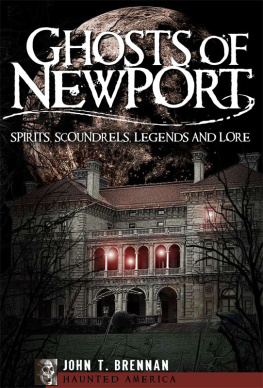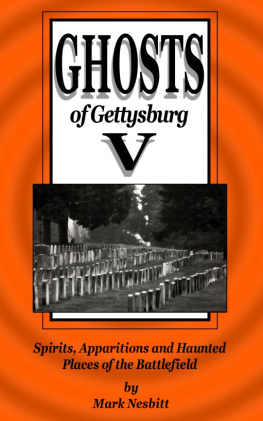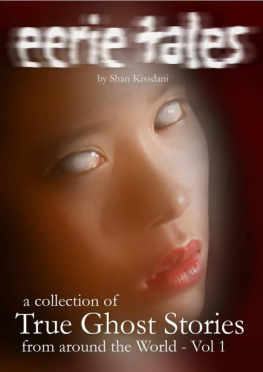Contents
SPIRITS OF PLACE

Edited by John Reppion
Spirits of Place
Copyright 2016 Daily Grail Publishing
Contributing authors retain ownership and all rights to their individual pieces.
Edited by John Reppion (www.moorereppion.com)
Cover art and design by Pye Parr (pyeparr.blogspot.com)
All rights reserved. No part of this book may be reproduced, stored, or transmitted in any form without permission in writing from the publisher, except by a reviewer who may quote brief passages for review purposes.
Daily Grail Publishing
Brisbane, Australia
userhelp@dailygrail.com
www.dailygrail.com
Editor's Introduction

By John Reppion
When I was a child I had a vision of fourth dimensional time; of paths trod by my own ghosts, past and future. My parents and my grandparents lived six houses apart on the same suburban South Liverpool street. In front of my parents' house (where they still reside) is a square of turf for kids to play on which we call "the grass patch". A journey from one house to the other could be made one of three ways: diagonally across the grass patch; via the strip of pavement which runs round its front closest to the road; or on the pavement round its back, past the front fences of numbers 50, 48, 46, and 44, and then at a right-angle up the far side, past the garage at number 42. I was on my way home from Gran's at the age of perhaps seven or eight when I was suddenly struck by the thought that I must already have made the journey a hundred times, and that I would make it thousands more. I crossed over on to the opposite side of the road so I could get a better look at that strip of land where, I realised with a weird dizzy feeling, I had already spent a good chunk of my young life. I saw imagined, I suppose, but with absolute clarity at first just a handful, but gradually a crowd. The diagonal route across the grass was the most heavily populated, in spite of all those warnings about muddy shoes. There I was at the age of three, four, five, and as I stared longer, there I was at ten, at seventeen, at twenty, at thirty; infant, child, adolescent, and adult overlaid in a blur of bodies, limbs and faces. An entire lifetime of journeys between those two fixed points in a single image an image I can still recall perfectly to this day. My younger selves dominate the picture, not because of nostalgia, but because I would walk the walk five or six or more times a day when I was a child, the frequency growing less and less beyond the age of ten. Gran died in 2010, Grandad followed her the next year, and their house the house my mum was born in was sold soon after. I couldn't have known that then, yet still there were (and are) very few, if any, versions of myself in that strange multi-exposure vision much past the age of thirty. For a long, long time after that mid-80s day, every time I made the journey I knew I was walking among, and with, and through all those other versions of myself. Versions which remain frozen there to this day not just in my head, but in some very real sense. I've never discussed any of this with anyone never even thought about it in any terms other than those which my younger self knew to be true and in fact, I had all but forgotten about it up until just a few days ago.
How can I best define the concept of "Spirits of Place"? It sounds good, but what do I even mean by the phrase? These are some of the questions I was asking myself last week. You might well think I should already have answered them quite a while ago; before commissioning the twelve pieces for this book, or indeed organising the conference/ritual mash-up thing which led to its creation. But no. At least, not exactly. It's easy enough to give people a rough idea of what you mean about something, especially if you're trying to give them just enough to spin their own ideas out of it. So, let's backtrack a little here. Not as far back as the 1980s, but to the first quarter of this year.
Spirits of Place was the name I chose for a one day event I organised and put on here in Liverpool in April, 2016. The idea came about when I saw that there was a conference space available for hire in the former Manor House in Calderstones Park; a park which I've been visiting on a regular basis for most of my life. There you'll find a playground, the duck and goose crowded mini-lake, a caf, an ice-cream parlour, ornamental gardens, a miniature railway, and the remains of a Neolithic chambered tomb.
The tomb stood just outside the boundaries of the park between 3000 BCE (give or take a few centuries) and 1804 CE, when it was pulled apart to make way for a house being built. All that survived of the tomb were six stones, each covered with curious spirals, circles, and other ancient engravings. These Calderstones the origin of the name long lost now were re-arranged into a rough stone circle under orders of lead shot manufacturer Joseph Need Walker in 1845. Standing at the South East entrance to Walker's estate mere metres from the tomb's original position the stones soon drew the interest of several 19th century antiquarians believing it to be their original "Druidic" location and configuration. There they remained until 1954 when they were removed under orders of Liverpool Corporation. Covered with more than a century's worth of moss and soot, the stones were cleaned and latex impressions taken, revealing details of carving which had previously been all but invisible to the naked eye. The first thorough survey of the stones was made based on these (now lost) moulds by J. L. Forde-Johnson and the results were published in his 1957 paper "Megalithic Art in the North West of Britain, The Calderstones, Liverpool". In 1964 the stones were relocated inside the park which by now bore their name. There in a hexagonal glass house (known as "the vestibule") which served as an entranceway to the Greenhill Greenhouses where a huge botanical collection was kept, the ancient, fragile Calderstones were set into grey slabs of quick drying concrete. The Greenhill Greenhouses were bulldozed in the 1980s following a strike by Liverpool council parks and gardens workers. The vestibule survived, standing alone; the Calderstones visible only to those who knew where to look, peering through the ivy and graffiti covered glass to see the sextet of standing stones holding their silent communion.
The first time I ever got to see the Calderstones up close was in 2007 on a Halloween tour of the park. The vestibule was warm and damp electric heaters working against the foggy October air in an effort to shield the megaliths from winter's chill. Fine spider's webs, spun across the pitted surfaces of the menhirs, were frosted with moisture, glistening in the glow of the heater elements. The engravings shimmered fierily as if each stone had a core of liquid magma beneath its brittle sandy surface. Our guide hurried through a truncated history of the stones and, for a precious few moments, the assembled crowd stared at them in absolute wonder. But, all too soon, the spell was broken. The park ranger had no eerie tale directly connected to the stones to tell. By the time we left the vestibule, his latest off the peg ghost story had all but erased the circle of crumbling stones' brief, vague history from most people's minds. With each step away from the dilapidated greenhouse, the illusionary fire within the ancient sigils seemed to dim. My own interest did not, however.
I became more fascinated than ever with the Calderstones and their history. How these man-made objects had been a permanent feature of the local landscape since mammoths walked the earth. Key elements of a tomb built before the Egyptian pyramids, marked with symbols which pre-date written language in this part of the world; their original meanings and purpose lost in the mists of time. In December 2014 I had one of these magical marks a thumbprint-like spiral pattern from the Calderstone that Forde-Johnson designated as Stone E tattooed in black ink on my right forearm. Although I have no way of knowing what it meant when it was carved, I know what it represents now. It is a connection between myself and the landscape; between the people who lived and died and left the mark here five millennia ago, and the life myself and my family live here now. A five-thousand year 4D snapshot of that crucial not-quite-a-mile of South Liverpool parkland would show the Calderstones as the only constant feature the spiral patterns graven upon their surfaces an almost perfect map of their glacial, stop-motion meanderings around its narrow environs. The Calderstones physically anchor Calderstones Park to England's ancient past. They are the proverbial heavy ball-bearing on the rubber-sheet of Time; creating a pocket of deep history into which stories, and spirits, are drawn in ever-decreasing orbits. And that is why I decided that putting on an event in the park would be a good idea. An attempt at harnessing that energy, and raising those spirits; the Spirits of Place.

